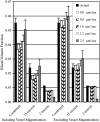NMR simulation analysis of statistical effects on quantifying cerebrovascular parameters
- PMID: 17085487
- PMCID: PMC1779980
- DOI: 10.1529/biophysj.106.087965
NMR simulation analysis of statistical effects on quantifying cerebrovascular parameters
Abstract
Determining tissue structure and composition from the behavior of the NMR transverse relaxation during free induction decay and spin echo formation has seen significant advances in recent years. In particular, the ability to quantify cerebrovascular network parameters such as blood volume and deoxyhemoglobin concentration from the NMR signal dephasing has seen intense focus. Analytical models have been described, based on statistical averaging of randomly oriented cylinders in both the static and slow diffusion regimes. However, the error in estimates obtained from these models when applied to systems in which the statistical assumptions of many, randomly oriented perturbers are violated has not been systematically investigated. Using a deterministic simulation that can include diffusion, we find that the error in estimated venous blood volume fraction and deoxyhemoglobin concentration obtained using a static dephasing regime statistical model is inversely related to the square root of number of blood vessels. The most important implication of this is that the minimum imaging resolution for accurate deoxyhemoglobin and blood volume estimation is not bound by hardware limitations, but rather by the underlying tissue structure.
Figures






Similar articles
-
Venous refocusing for volume estimation: VERVE functional magnetic resonance imaging.Magn Reson Med. 2005 Feb;53(2):339-47. doi: 10.1002/mrm.20352. Magn Reson Med. 2005. PMID: 15678548
-
Theory of susceptibility-induced transverse relaxation in the capillary network in the diffusion narrowing regime.Magn Reson Med. 2005 Mar;53(3):564-73. doi: 10.1002/mrm.20394. Magn Reson Med. 2005. PMID: 15723392
-
Validation of quantitative estimation of tissue oxygen extraction fraction and deoxygenated blood volume fraction in phantom and in vivo experiments by using MRI.Magn Reson Med. 2010 Apr;63(4):910-21. doi: 10.1002/mrm.22274. Magn Reson Med. 2010. PMID: 20373392
-
Quantification of modulated blood oxygenation levels in single cerebral veins by investigating their MR signal decay.Z Med Phys. 2009;19(1):48-57. doi: 10.1016/j.zemedi.2008.07.005. Z Med Phys. 2009. PMID: 19459585
-
Simultaneous acquisition of cerebral blood volume-, blood flow-, and blood oxygenation-weighted MRI signals at ultra-high magnetic field.Magn Reson Med. 2015 Aug;74(2):513-7. doi: 10.1002/mrm.25431. Epub 2014 Sep 5. Magn Reson Med. 2015. PMID: 25195774
Cited by
-
Tissue oxygen saturation mapping with magnetic resonance imaging.J Cereb Blood Flow Metab. 2014 Sep;34(9):1550-7. doi: 10.1038/jcbfm.2014.116. Epub 2014 Jul 9. J Cereb Blood Flow Metab. 2014. PMID: 25005878 Free PMC article.
-
Enhancing MR vascular Fingerprinting with realistic microvascular geometries.Imaging Neurosci (Camb). 2024 Dec 16;2:imag-2-00377. doi: 10.1162/imag_a_00377. eCollection 2024. Imaging Neurosci (Camb). 2024. PMID: 40800258 Free PMC article.
-
Biophysical modeling of phase changes in BOLD fMRI.Neuroimage. 2009 Aug 15;47(2):540-8. doi: 10.1016/j.neuroimage.2009.04.076. Epub 2009 May 5. Neuroimage. 2009. PMID: 19426815 Free PMC article.
-
An efficient computational approach to characterize DSC-MRI signals arising from three-dimensional heterogeneous tissue structures.PLoS One. 2014 Jan 8;9(1):e84764. doi: 10.1371/journal.pone.0084764. eCollection 2014. PLoS One. 2014. PMID: 24416281 Free PMC article.
-
MR vascular fingerprinting: A new approach to compute cerebral blood volume, mean vessel radius, and oxygenation maps in the human brain.Neuroimage. 2014 Apr 1;89:262-70. doi: 10.1016/j.neuroimage.2013.11.052. Epub 2013 Dec 7. Neuroimage. 2014. PMID: 24321559 Free PMC article.
References
-
- Yablonskiy, D. A., and E. M. Haacke. 1994. Theory of NMR signal behavior in magnetically inhomogeneous tissues: the static dephasing regime. Magn. Reson. Med. 32:749–763. - PubMed
-
- Kiselev, V. G., and D. S. Novikov. 2002. Transverse NMR relaxation as a probe of mesoscopic structure. Phys. Rev. Lett. 89:278101. - PubMed
-
- Sukstanskii, A. L., and D. A. Yablonskiy. 2001. Theory of FID NMR signal dephasing induced by mesoscopic magnetic field inhomogeneities in biological systems. J. Magn. Reson. 151:107–117. - PubMed
-
- Yablonskiy, D. A. 1998. Quantitation of intrinsic magnetic susceptibility-related effects in a tissue matrix. Phantom study. Magn. Reson. Med. 39:417–428. - PubMed
Publication types
MeSH terms
Substances
LinkOut - more resources
Full Text Sources

